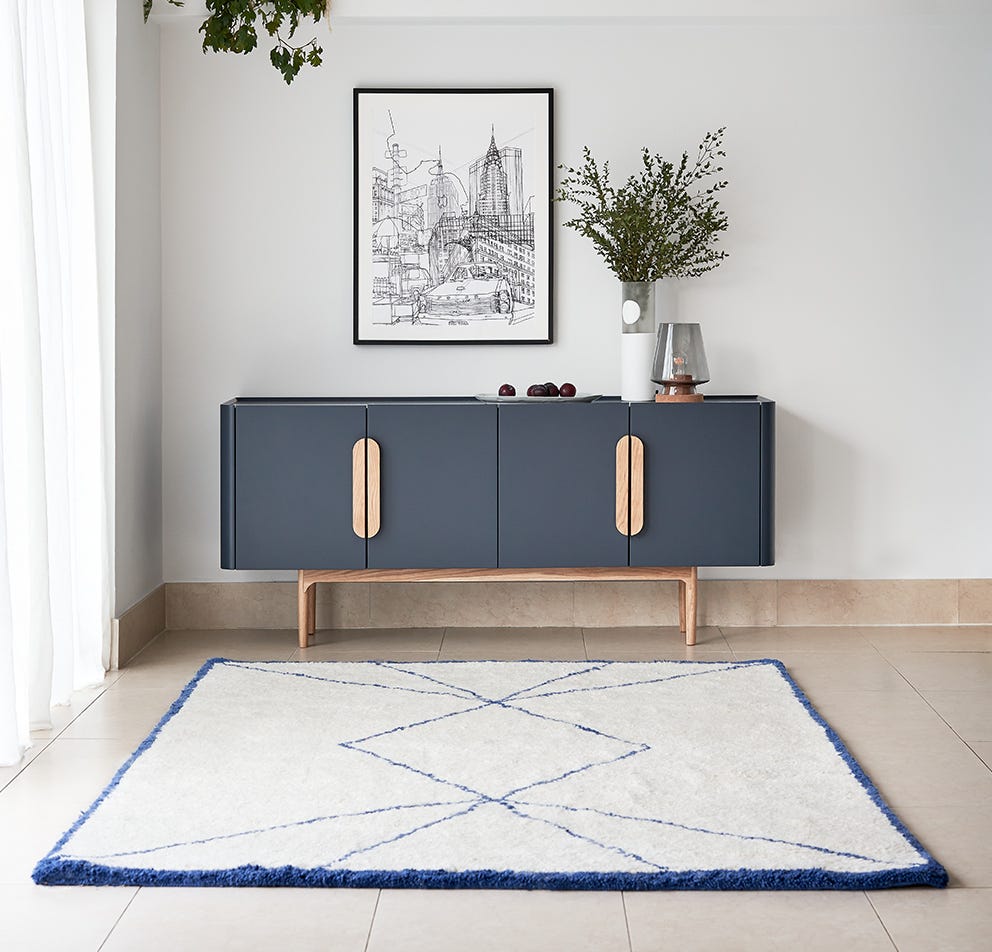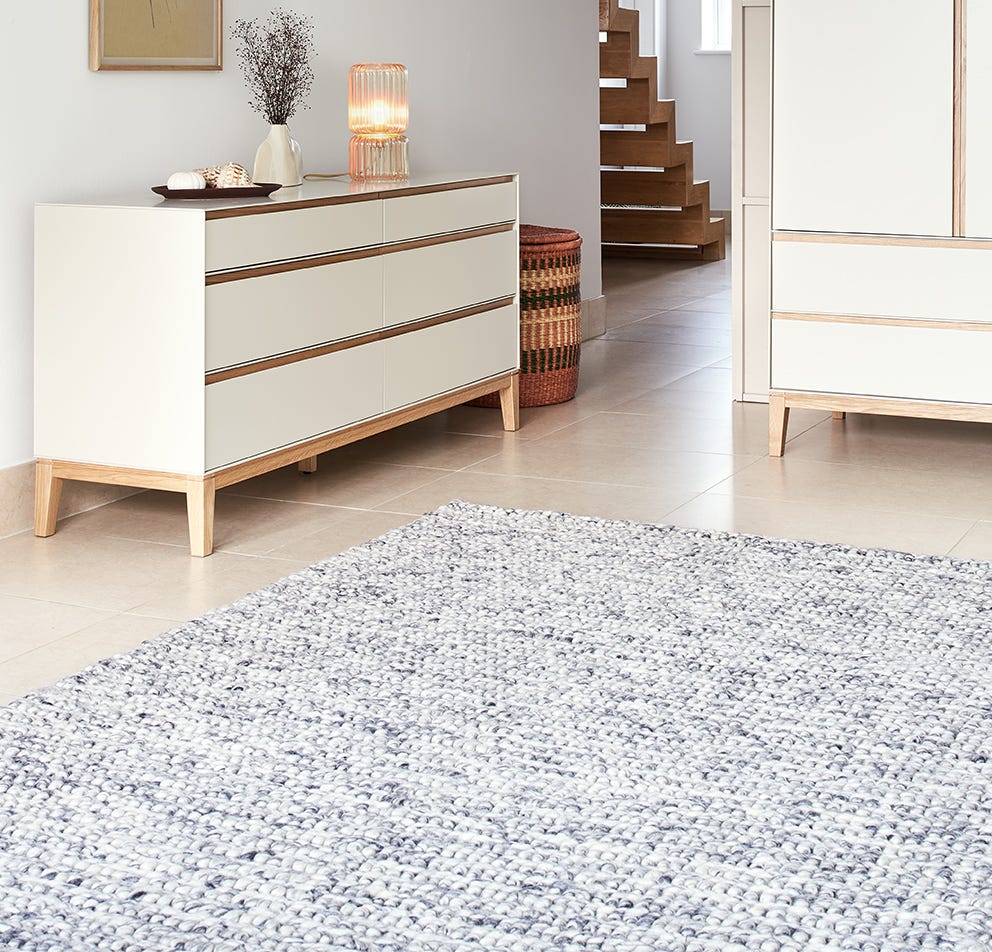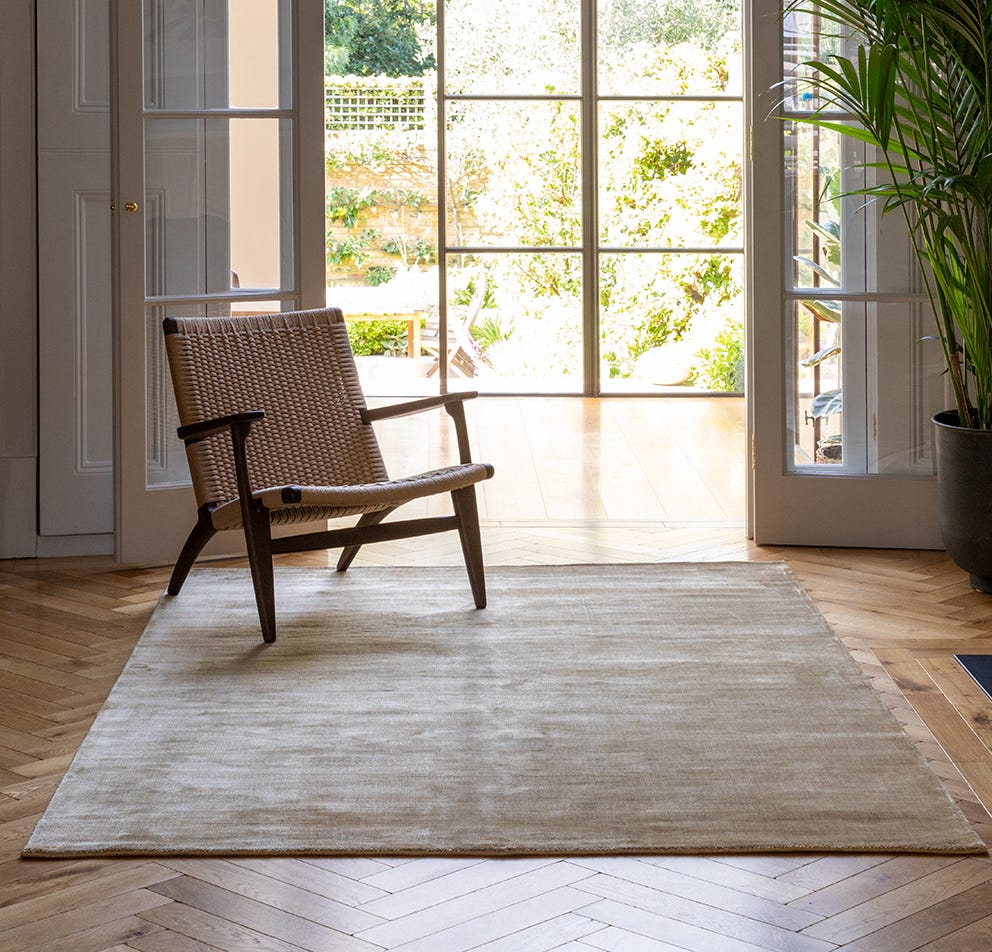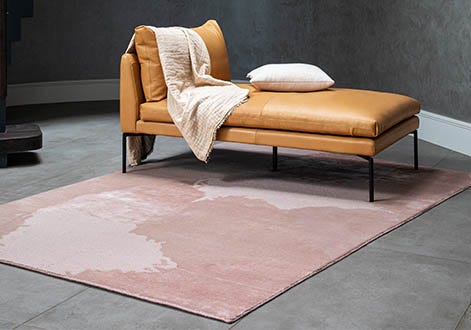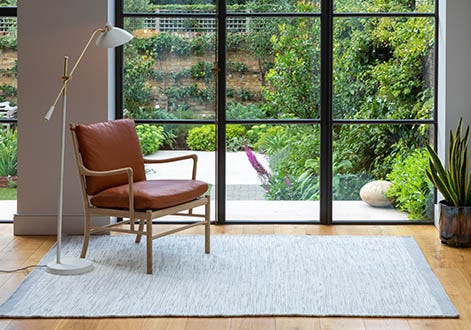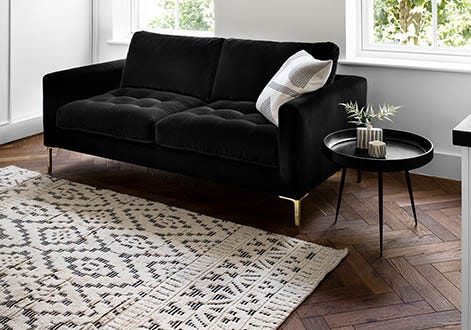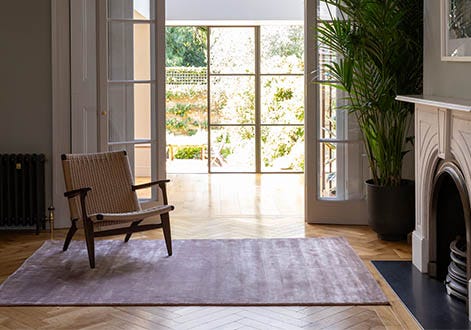Rug Buying Guide
From bold patterns to minimal designs, our wide range of sizes and styles can provide the missing link to tie your interior scheme together or create a visually striking focal point around which to frame the décor.
Looking for a rug to sweep you off your feet? We’ve done the ground work for you
A beautifully woven rug makes a comforting addition to a room while also helping to soften the space. Yet, as with any piece of furniture, the type of rug you choose will depend upon the space available, the layout of the room and the look and feel desired.
How to layout your rug
As with any piece of furniture, the type of rug you choose will depend upon the space available and the layout of the room.
Different rooms have different functions, so any rug should fit into or accommodate such requirements providing a frame for or accompaniment to the existing furniture. Identifying a basic layout helps refine your search while also ensuring that any addition to the room works within the existing interior plan.


Living Room Layout
Classic Layout: Within a smaller living room, furniture is often pressed against the walls to maximise the space. For such a layout, choose a rug that is large enough to accommodate a coffee table as well as sit neatly underneath the front legs of the sofa and each additional chair. This provides a simple border around the edge of the room while providing a comfortable tread within the centre of the space.
Floating Layout: A larger social or occasional room can not only house more furniture but also create more space between each piece. Even so, chairs and sofas will tend to be positioned relatively close to each other within the centre of the room, what’s known as floating, and thus require a large rug that can easily accommodate the legs of each piece.


Dining Room Layout
Dining Layout: At the heart of the room, the dining table must be adequately framed to provide a comfortable experience in terms of both form and function. Ensure you measure the table and the room carefully adding two feet on each side for the dimensions of the rug. While the shape of your table may provide room for experimentation – provided the proportions match, a square table can work well on a circular rug and vice versa – a traditional, rectangular form works best when paired with a similar shaped rug.


Bedroom Layout
Bedroom Layout: Though many bedrooms opt for either carpeted or solid flooring, the addition of a rug creates a break between the bed and the rest of the furniture. An ideal shape and position is to lay a rectangular rug across the room around two thirds from the bottom of the bed so that it sits underneath the feet at the end but not the top.
Our fabrics
While many rugs tend to be made from pure wool, the types of yarn used in the weaving process not only effect the design or pattern of the piece but also the colour, texture and feel.
Wool: A diverse material that is renowned for its longevity, wool can be treated in numerous ways to create an ultra-soft feel or coarser texture. Hardwearing and resilient, it is well suited to family homes.
Cotton: Durable and soft, cotton allows for intricate, tightly woven designs that are great for patterns and also blends well with other materials to provide greater economy.
Jute: the golden, barley tones of jute give it a natural feel that looks all the more rustic when thickly woven by hand. This fibrous material has a rugged texture to match its durability and blends well with cotton to create contrasting colour designs.
Hemp: The bristly texture of hemp is countered by its bright, beige tones that look best when traditionally woven. Applied to a cotton backing for support, hemp rugs prove a hardy addition to the room.
Hides: though less common, some rugs are made from a patchwork of natural hides – the leather material aging beautifully over time.
Types of rug
While it’s one thing to produce and dye the yarn, the true beauty a rug lies in its construction. Throughout the centuries cultures and civilisations from across the globe have contributed their own style of producing rugs, with a number of these designs still in evidence in our collection today alongside pieces that use the latest manufacturing processes. Many of the rugs sold at Heal’s are made by hand, focusing on the craft that goes into each individual thread.
Knotted: Often slightly more expensive due to their labour intensive production process, knotted rugs are a worthwhile investment thanks to their strength and durability. Traditional Middle Eastern rugs are a classic example of how using different coloured threads can create complex patterns, with the quality of a knotted rug determined by the thread count per square inch - the higher the number of knots, the more intricate the design.
Tufted: Comfortable under foot, tufted rugs are crafted by punching strands of wool onto a stretched canvas frame before finishing with a fabric backing to hold the pile in place. Hard-wearing over time, the soft feel and smooth texture of a tufted rug is perfect for projecting complex patterns and designs – think unusual shapes, painterly lines, and bright, contrasting colours.
Woven: Crafted either by hand or using a traditional loom-weaving process, woven rugs are often made from a cotton blend that not only makes them long-lasting but also more affordable. The neat alignment of threads make woven rugs ideal for reproducing geometric patterns - a tight weave allows for a greater level of detail, both in terms of the pattern and the mix of colours, while using thick strands of material can provide an interesting texture that stands out.
Looking after your rug
Once you’ve got your rug home and are happy with the layout, it’s important to remember to look after it. Sure, most rugs may be designed and crafted to be hardwearing, however, like any piece of furniture they still need a bit of TLC once in a while. A few points to remember in caring for your rug:
Quick turnaround: insects such as moths love gorging on natural fibres and are thus natural enemies of your rug, while over time long exposure to natural sunlight can also lead to colour fading. To protect against the elements, lift and turn your rug every 6 or so months - especially if any part is under furniture.
Safeguard: when arranging your furniture, it is wise to have some sort of protection under the legs to prevent the carpet fibres from being crushed. Also try to avoid sharp castors or narrow legs and move furniture the around from time to time to prevent nasty looking indents on the surface of the rug.
Slip-up: if your rug is to be laid straight onto a smooth surface such as tiles or wooden flooring it is advised that a rug underlay is used to prevent the rug from slipping when walked across. In certain circumstances, deep coloured dyes may also transfer to the flooring beneath and therefore require a rug hold underlay for added protection.
Stop the rot: never lay a rug on a damp floor as overtime the wet can lead to rot. If any such problem does arise, seek professional help in cleaning the rug.
Cleaning
If your chosen rug specifies ‘specialist clean only’ we recommend you leave any stain and seek a specialist cleaning service at your earliest convenience. This will minimise any further damage to the colour, shape and finish of your rug. However, if our care instructions on your chosen rug don’t specify ‘specialist clean only’, there are a few things you can do to maintain it:
Loose ends: on a new woollen rug it is normal to find loose fibres that will eventually malt, however, avoid excessively vacuuming your rug otherwise you could cause undue shedding (especially those with a longer or looser pile).
Shake and vac: an effective way to routinely clean your rug is to simply beat with a wooden pole to loosen any ground in dirt before brushing or lightly vacuuming away.
Problem stains: any spillage of food or drink will require immediate attention. If your rug is made from a hardwearing material like jute, sisal or is a flatweve, simply moisten a cotton cloth with cold water, wring out and lay on the stain before leaving to dry. If your rug is made from a more delicate material, like viscose or velvet, we would suggest arranging a visit from a specialist cleaning service as soon as possible.
Things to Consider
Will it fit?
While many rugs tend to be made from pure wool, the types of yarn used in the weaving process not only effect the design or pattern of the piece but also the colour, texture and feel. Wool: A diverse material that is renowned for its longevity, wool can be treated in numerous ways to create an ultra-soft feel or coarser texture. Hardwearing and resilient, it is well suited to family homes. Cotton: Durable and soft, cotton allows for intricate, tightly woven designs that are great for patterns and also blends well with other materials to provide greater economy. Jute: the golden, barley tones of jute give it a natural feel that looks all the more rustic when thickly woven by hand. This fibrous material has a rugged texture to match its durability and blends well with cotton to create contrasting colour designs. Hemp: The bristly texture of hemp is countered by its bright, beige tones that look best when traditionally woven. Applied to a cotton backing for support, hemp rugs prove a hardy addition to the room. Hides: though less common, some rugs are made from a patchwork of natural hides – the leather material aging beautifully over time.
TOP TIP
Use masking tape or newspaper to lay out the size of your sofa. This will give you a good indication as to whether you are happy with how much space it takes up.
How durable does it need to be?
Sofas come in many different shapes and sizes and it’s important to choose the one that is right for your home. If you’re looking for a sofa that will see a lot of use from you and the children, explore family-friendly designs that are low maintenance.
By this we mean sofas upholstered in a dark, durable fabric that won’t easily stain and with foam-filled cushions that don’t need constant plumping. If you're looking for a sofa that will make a design statement whilst also remaining comfortable and inviting, the world is your oyster.
TOP TIP
The legs of some of our sofas are able to removed, lowering the height by 15-20cm. Ask a member of our customer support team for more information.
What style should I choose?
Rather than limit yourself by trend, it’s best to discover your ‘design style’ instead. These are much broader and encompass more than just pattern, texture and material.
Mid-century style, for example, is characterised by tapered legs, fuss-free design and a simple aesthetic. While Scandi style also has an emphasis on clean lines, it places more of an emphasis on tactile, natural materials and organic shapes.
We suggest identifying a style that resonates with you and consider how it will fit in with the style of your home.
TOP TIP
Trends may come and go but a sofa should last a lifetime. It’s important to choose furniture that's true to your own style rather than a trend that can disappear as quickly as it arrived.
Things to Consider
Will it fit?
While many rugs tend to be made from pure wool, the types of yarn used in the weaving process not only effect the design or pattern of the piece but also the colour, texture and feel. Wool: A diverse material that is renowned for its longevity, wool can be treated in numerous ways to create an ultra-soft feel or coarser texture. Hardwearing and resilient, it is well suited to family homes. Cotton: Durable and soft, cotton allows for intricate, tightly woven designs that are great for patterns and also blends well with other materials to provide greater economy. Jute: the golden, barley tones of jute give it a natural feel that looks all the more rustic when thickly woven by hand. This fibrous material has a rugged texture to match its durability and blends well with cotton to create contrasting colour designs. Hemp: The bristly texture of hemp is countered by its bright, beige tones that look best when traditionally woven. Applied to a cotton backing for support, hemp rugs prove a hardy addition to the room. Hides: though less common, some rugs are made from a patchwork of natural hides – the leather material aging beautifully over time.
TOP TIP
Use masking tape or newspaper to lay out the size of your sofa. This will give you a good indication as to whether you are happy with how much space it takes up.

